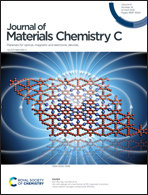An organic microlaser based on an aggregation-induced emission fluorophore for tensile strain sensing†
Abstract
With the wide use of micro–nano photonic devices in on-chip optical communication, physical and chemical sensing, organic microlasers have gained increasing attention owing to their special advantages including high integration, easy preparation and excellent optical properties. However, traditional microlasers suffer from the “aggregation-caused quenching” (ACQ) effect of gain molecules and high lasing thresholds. In this contribution, we meticulously designed organic microlaser assemblies based on an “aggregation-induced emission” (AIE) fluorophore for its unique characteristics. An innovative AIE fluorophore, namely triphenylamine-benzo[1,2-b:4,5-b′]-dithiophene 1,1,5,5-tetraoxide (TPA-BDTO), with highly efficient emission at the aggregated state is employed to hybridize with the PMMA matrix, obtaining microbottles with an ultra-smooth surface via the self-assembled strategy. Benefiting from the spatially well-separated intensity based on the prolate shape of the TPA-BDTO–PMMA microbottle, we realize a single-mode microlaser in a microbottle with an appropriate pump power via precise manipulation. Moreover, the TPA-BDTO–PMMA microlaser is demonstrated as an axial tensile strain sensor with high sensitivity (0.34 pm με−1), high resolution, real-time response and simple structure, which create new opportunities for organic microlasers and even lay a foundation for the research of lab-on-chips.



 Please wait while we load your content...
Please wait while we load your content...